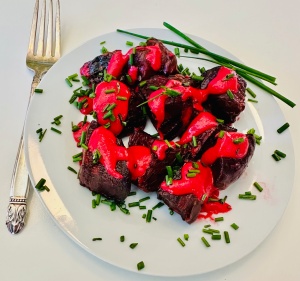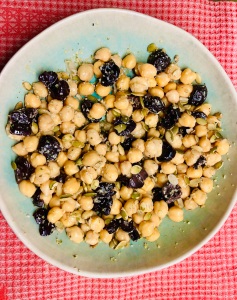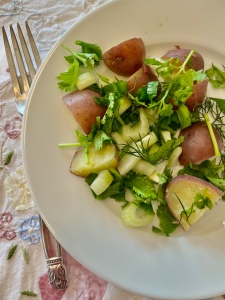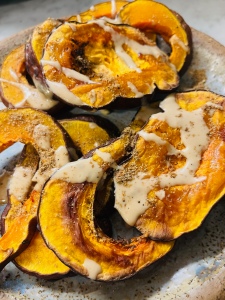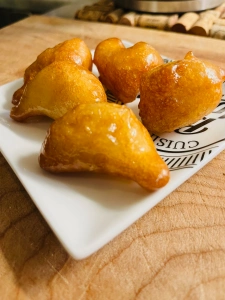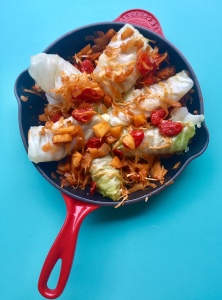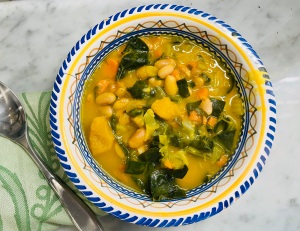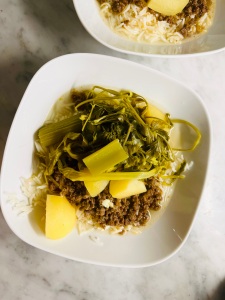Instead of a shank bone, many people now replace it with a roasted beet on their seder plate (z’roa) as a representation of the pascal lamb, for a veg based meal. Inspired by this custom, I decided to prepare a roasted beet dish. I used red beets but you could use golden or an assortment. I love the versatility of beets-raw, roasted, liquified, and more. This one is a combination of roasted beets as well as tahini with roasted beets. Added bonus are the chives I clipped from my sister’s garden to sprinkle on top. Scroll below for the recipe plus my other previous Pesach recipes including karpras salad and olive oil chocolate cake. And, click here to learn about leaving an empty seat at your seder table for a hostage. Continue reading
Purim: Queen Esther’s Salad
You might be wondering where the hamantaschen recipe is (scroll to the bottom) or why I’m sharing a bean recipe for Purim. The Queen Esther salad that I created is for a Purim seudah (meal) and is made with many symbolic ingredients. First, according to Gil Marks in Olives and Honey Trees, chickpeas are a traditional Ashkenazi food eaten at Purim (amongst other celebrations). Olives are a symbol of mourning and also commonly eaten in Purim dishes that symbolized Haman (along with eggs and other ingredients like noodles), as explained in Claudia Roden’s, The Book of Jewish Food. Last, there’s a Talmudic teaching that Queen Esther became a vegan, eating just legumes and seeds while she lived in King Achashaverus palace, to ensure she did not eat non kosher foods (another bonus of being vegan :)). I generally sprinkle seeds on my salad, because I like the crunchy texture and contrasting flavors they provide. And, if you’re looking for more delicious (and sweet) Purim recipes, they are at the bottom of the post (including two types of hamantaschen)! Continue reading
Sukkot Couscous & Fall Vegetables
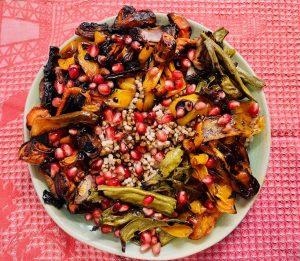 I love Sukkot–eating outside, enjoying fall fruits and vegetables, deepening our connections with nature and agricultural cycles. I recently spent time at an incredible native plants nursery near my home. It was fantastic: endless rows of plants native to the Mid-Atlantic region with detailed signs explaining the type of soil and sun they prefer. Between the rows the ground was deep mud and water after heavy rains for two days. Trudging along the rows in my rain boots, I just wanted to buy everything! The native plants are essential because they are “native” to the region in which they evolved and planting them helps to support biodiversity that attracts pollinators such as bees as well as butterflies and birds, better absorbs groundwater retention, and doesn’t require the use of chemicals. Perhaps native plants don’t look as neat and trim as other gardens but they are humming, buzzing and flourishing. The Sukkot dish I made reinforces the importance of local, sustainable agriculture and happens to be easy and delicious. Continue reading
I love Sukkot–eating outside, enjoying fall fruits and vegetables, deepening our connections with nature and agricultural cycles. I recently spent time at an incredible native plants nursery near my home. It was fantastic: endless rows of plants native to the Mid-Atlantic region with detailed signs explaining the type of soil and sun they prefer. Between the rows the ground was deep mud and water after heavy rains for two days. Trudging along the rows in my rain boots, I just wanted to buy everything! The native plants are essential because they are “native” to the region in which they evolved and planting them helps to support biodiversity that attracts pollinators such as bees as well as butterflies and birds, better absorbs groundwater retention, and doesn’t require the use of chemicals. Perhaps native plants don’t look as neat and trim as other gardens but they are humming, buzzing and flourishing. The Sukkot dish I made reinforces the importance of local, sustainable agriculture and happens to be easy and delicious. Continue reading
Rosh Hashana: Black Eyed Peas
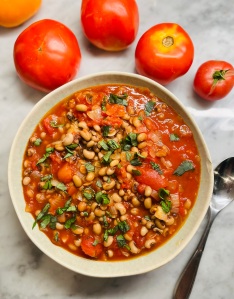 I recently read Michael Twitty’s latest fabulous book, Koshersoul, a personal and culinary exploration as a Black Jewish man. Beautifully written with lots of recipes that trace the intersections and influences of African foods, African-American cuisine, Jewish Southern dishes, and Sephardic foods. One ingredient he wrote about was black eyed peas, commonly found in African, African-American and Sephardic and Mizrachi dishes. Black eyed peas are commonly eaten at Rosh Hashana as a symbol of a prosperous new year. Continue reading
I recently read Michael Twitty’s latest fabulous book, Koshersoul, a personal and culinary exploration as a Black Jewish man. Beautifully written with lots of recipes that trace the intersections and influences of African foods, African-American cuisine, Jewish Southern dishes, and Sephardic foods. One ingredient he wrote about was black eyed peas, commonly found in African, African-American and Sephardic and Mizrachi dishes. Black eyed peas are commonly eaten at Rosh Hashana as a symbol of a prosperous new year. Continue reading
Passover: Karpas Salad
This is a really easy, yummy salad filled with lots of karpas or related ingredients. The karpas course of the seder includes a vegetable (often parsley or potatoes) that is symbolic of spring and then dipped in salt water, representative of the Israelites tears. This salad can be served. If you eat light foods during your seder before the main meal, this is an easy addition to the meal that can be quickly prepared. Also, scroll down for my other Passover recipes including sweets and savory dishes. Continue reading
Antwerp & Roasted Pumpkin
I spent the first day of 2023 in Antwerp, a city with one of the largest Chasidic populations in Europe. A famous kosher restaurant, Hoffy’s, was open and we excitedly arrived for lunch. We were told to come back in about an hour when they were ready. We walked around the neighborhood (which abuts the city’s diamond district). The area was empty–besides Hoffy’s and a kosher market and a quick stop into the Portuguese synagogue, nothing was open and few people were out. We returned to Hoffy’s which was filled with strong aromas wafting from the kitchen while staff hurriedly ran around getting the dining area ready, placing small flower vases and candles on tables while waiters quickly wrapped aprons around their waists. Continue reading
Awame
Awame (also called awamat) is a Syrian and Lebanese dessert that is often eaten during Chanukah. It’s akin to a Chanukah sufganiyot (donuts) but instead of stuffed with jam, they are lightly fried in oil and soaked in orange blossom water infused syrup. Though they are fried in oil, they’re light and not dripping in oil. They leave a delicious sweet stickiness on your fingers. For more of my Chanukah recipes, scroll to the bottom of the post. Chanukah Sameach! Continue reading
Shmini Atzeret and Simchat Torah Recipes Round-Up
A quick post to share recipes for both Shmini Atzeret and Simchat Torah. Simchat Torah is one of my favorite holidays.The foods we eat are stuffed, scroll or round-shaped to represent the abundance of the Torah. In a previous holiday post, I wrote: “Simchat Torah symbolizes the cycles of our lives. As the Earth rotates, our lives rotate throughout the year; Torahs scroll cycle along their wooden spines each week; our food grows in cycles; on Simchat Torah while holding the Torah, we circle as a community; and we cycle together throughout the Jewish calendar. Continue reading
Yom Kippur Break-Fast: Kabocha Squash Soup
This is a really easy, hearty soup that is a perfect meal pre or post fast (or both!). I like to end my Yom Kippur fast with nourishing, light foods and tend to avoid the deluge of heavy dishes I often find at many break-fast potlucks. This soup is nourishing and filling but not heavy. It is delicious both when immediately ready for pre-fast meal and after sitting overnight for break-fast with a slice of a dark bread to dip. If you can’t find a kabocha squash, try an acorn one. The squash should be slightly chunky so canned pumpkin isn’t the best option but is do-able in a pinch. Hope you have a meaningful, easy fast and holiday. Also, scroll to the bottom for my other Yom Kippur recipes. Continue reading
Orez v’chamoud
Orez (rice) v (and) chamoud (lemon chicken soup) is a Syrian Jewish dish that has been updated in this recipe to a delicious vegan version. The three part dish is a delectable balance of rice, vegan meat and creamy vegetables, assembled together with broth filled with lots of herbs and lemons, to be a hearty soup. Though it’s three parts, it’s not complicated to make and despite three pots to clean afterwards, I think that it’s worth the effort! Continue reading

